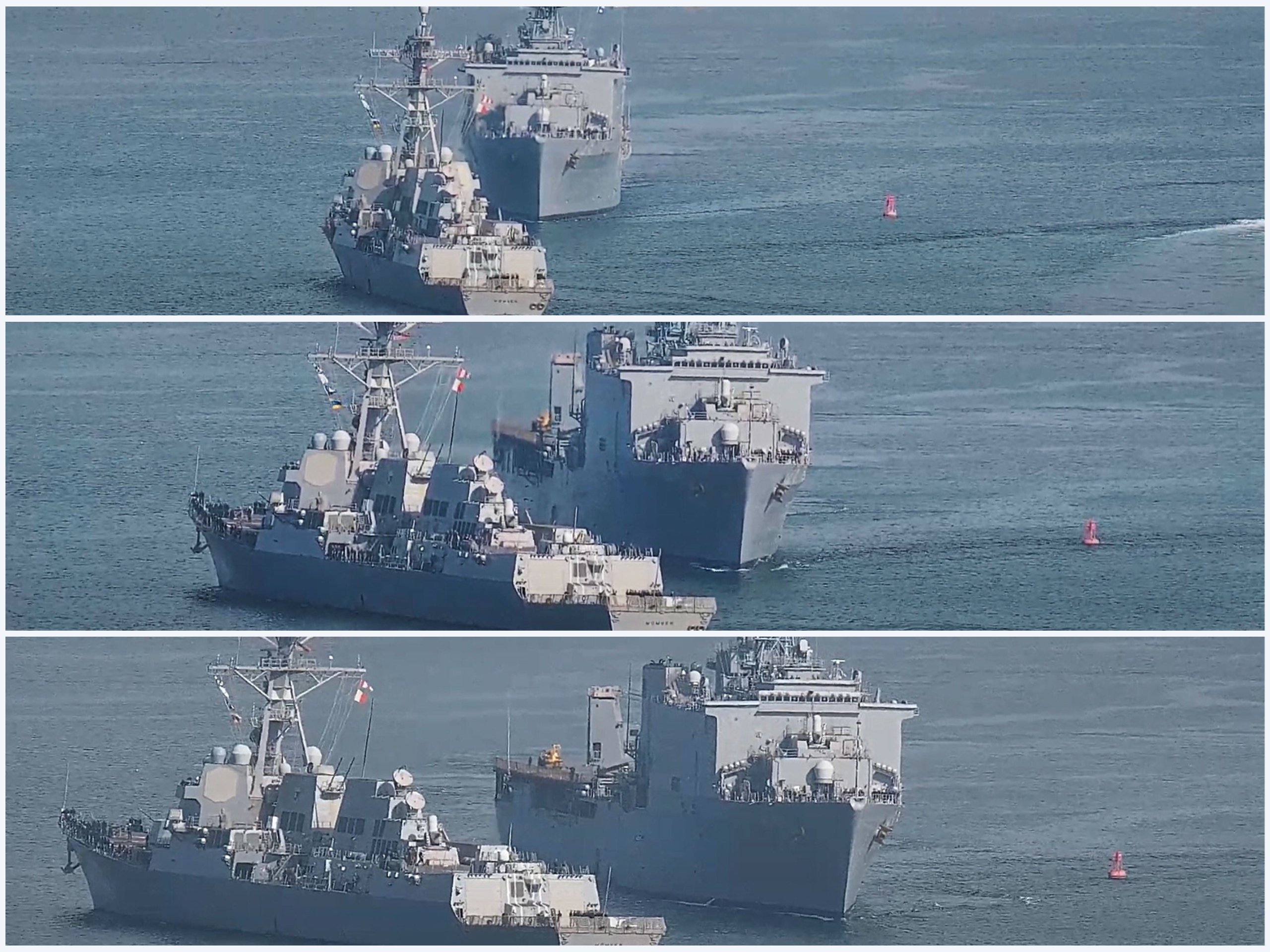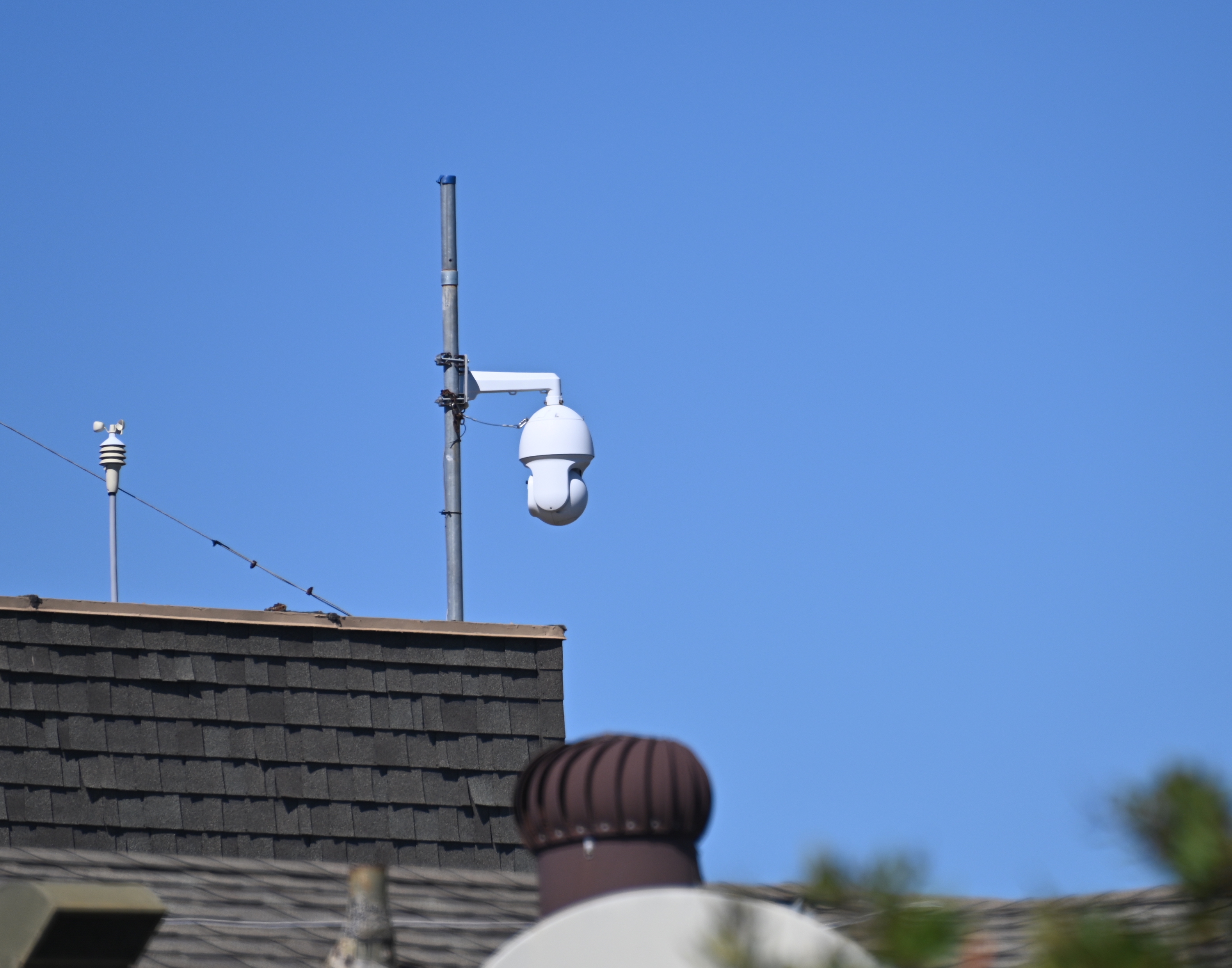
The quick thinking of two junior officers aboard an amphibious warship prevented a collision in San Diego Harbor in November, according to an investigation obtained by USNI News on Thursday.
The near-miss between USS Harpers Ferry (LSD-49) and guided-missile destroyer USS Momsen (DDG-92) in the narrowest part of San Diego harbor was prevented in part by the officer of the deck and navigator on Harpers Ferry who, during a moment of leadership indecision, ordered a turn that moved the 17,000-ton ship out of the way of the smaller, more maneuverable destroyer.
The commander of Momsen ordered the destroyer to turn at the same time, preventing the two ships from colliding at a tight corner a little under three miles from the harbor entrance, according to the report.
Vice Adm. Roy Kitchener, the commander of Naval Surface Forces, endorsed the preliminary investigation in January.
“This near-miss collision between warships reminds us of the inherent risk present during operations at sea,” Kitchener wrote in his endorsement. “We must reduce and mitigate those risks through a diligent and focused performance during special evolutions or transits in restricted waters.”
While mistakes were made in the pilot house of both ships, Kitchener elected to take no administrative action against the sailors and leaders involved.
“The investigation findings focused on counseling and self-assessment of those involved in the incident, formalizing procedures and clarifying standing orders, and emphasizing continued professional growth of our command triads and bridge teams,” Navy spokesman Cmdr. Arlo Abrahamson told USNI News in a Thursday statement.
“It’s also important to note that some members of the bridge teams were lauded for their actions in preventing a collision,” he said. “As noted in the investigation findings, this inquiry was an opportunity to critically assess processes and implement lessons learned to ensure this type of incident does not occur again.”
Tight Turn
Harpers Ferry left its pier at Naval Base San Diego on the morning of Nov. 29, 2022, heading west before an almost 90-degree turn south toward the harbor channel exit. Meanwhile, destroyer Momsen was returning to the naval base from a period underway.
The channel for San Diego Harbor is shaped like a hook curving around North Island. Ships leaving Naval Base San Diego sail northwest on a path that curves about 140 degrees around Naval Air Base North Island before heading almost due south through the channel.
Shortly after 10 a.m. local time, Harpers Ferry passed USS Tripoli (LHA-7) returning from its first deployment and headed into a turn in one of the tightest parts of the harbor.
Ships heading back to the naval base make the same trip in reverse through the narrow channel with piers, shallows and other hazards on either side of the harbor.
At 10:18, Harpers Ferry began a turn to port near the top of the channel. Coming north in the opposite direction, Momsen was bringing a harbor pilot aboard from a small tug.
Due to confusion on the bridge of Harpers Ferry, the watchstanders were unclear where Momsen was going. Based on the orientation of the ship, the Harpers Ferry bridge team thought Momsen could be cutting across the channel to the navy fuel pier.
In reality, Momsen had deviated from its planned passage and couldn’t turn to starboard with the tug attached. After bringing the pilot aboard, Momsen began its turn to starboard later than planned. By that point, Harpers Ferry had little room to maneuver.
“[Momsen] showed a target angle while embarking the pilot for almost 1.5 minutes that indicated they would not be able to comply with the [port to port] passage,” reads the investigation.
Unclear what Momsen was doing, the amphib’s commanding officer, Cmdr. Eric Winn, ordered Harpers Ferry to slow down and then stop to buy more time, but that diminished the amphib’s maneuverability.
“These actions show that [the Harpers Ferry] CO struggled in that moment to arrive upon the right solution to get [Harpers Ferry] out of danger. The period of indecision lasted for almost one minute and the rate of closure was about 333 yards every minute,” reads the investigation.
On the bridge of the amphib, Winn, the officer of the deck and the navigator gave contradicting orders that confused the conning officer.
“Interviews show at this time there was disagreement and confusion on the Harper Ferry bridge,” reads the investigation.
“In the critical moment when [Winn], [officer of the deck], and [the navigator] were all giving direction to the CONN, it is clear that the situation overwhelmed the CONN and she was no longer able to effectively execute her duties,” the report said.
The officer of the deck on Harpers Ferry took over as the conning officer and directed the ship to make a hard turn to port. Typically, the combat information center’s additional radars and sailors could have helped to track contacts, but the sailors were not aware of the situation on the bridge.
Meanwhile, Momsen’s commanding officer, Cmdr. Eric Roberts, and the bridge team realized that Harpers Ferry wasn’t in position for the ships to pass on each other’s port side. Roberts ordered the destroyer to make its own hard turn to port, avoiding a collision in one of the narrowest parts of the channel.
The two ships both turned to port at the same time, matching rudder movements, avoiding the collision and continuing on their path.
“Three major events prevented this near miss from being a collision: 1) the decisive actions taken by the Momsen Commanding Officer (CO) to maneuver to port, 2) the Officer of the Deck (OOD) onboard Harpers Ferry assuming CONN (Conning Officer) and maneuvering to port when he felt the point of extremis was reached, and 3) the decision by both the Momsen CO and Harpers Ferry OOD to shift rudders at approximately the same time to complete,” reads the investigation.
Aftermath
The investigation singled out the Harpers Ferry officer of the deck and navigator for praise in avoiding a collision, citing the improved officer of the deck training the Navy implemented after navigation errors aboard USS Fitzgerald (DDG-62) and USS John McCain (DDG-56) resulted in the death of 17 sailors.
“The forceful backup provided by the [Harpers Ferry navigator and officer of the deck] was exactly the type of support they should have provided to their CO and is an affirmation of the Harpers Ferry bridge team’s emphasis on training and the robust changes made in Surface Navy OOD training since the events of Fitzgerald and John S. McCain,” reads the investigation.
Earlier this week, a USNI News article explored how the revamped navigation training for surface warfare officers has improved the basic skills of junior officers entering the fleet.
Following the investigation, the commanders of both ships were directed to provide an extensive after-action report on what they could have done to improve their performance, a Navy official told USNI News this week.
In his endorsement, SWO Boss Kitchener highlighted the incident as a learning tool.
“This preliminary inquiry is an opportunity to critically assess processes and implement lessons learned to ensure this type of incident does not occur again,” he wrote.
Harbor Views

The near-miss incident may have never become public if not for the local San Diego Web Cam network. Footage of the incident was broadcast across the country following the incident.
One of two webcams the group operates from the Cabrillo National Monument on National Park Service property caught the incident. The park is perched on a hill overlooking the harbor entrance just south of a densely packed residential neighborhood.
In the report, investigators cite the camera footage as a key tool used to analyze the incident, since there was no voice or video recording of the bridge. The Coast Guard has also used the camera to help with operations and to respond to incidents in the harbor.
This week, the National Park Service cut internet access to the two webcams that had been operating for more than ten years, San Diego webcam founder Barry Barhrami told USNI News on Thursday.
In a statement to USNI News, NCIS said regional agents informally discussed the cameras with the Park Service staff and that the Park Service made the decision to cut off internet access.
“NCIS expressed force protection concerns related to the private webcams and YouTube channel, which provided 24-hour webcam monitoring of vessels and equities located aboard Naval Air Station North Island, including aircraft hangers/flight lines, Naval Base Point Loma submarine assets, and the tracking of military personnel working aboard Naval Base Coronado,” spokesman Jeff Houston told USNI News in a statement on Thursday.
Barhrami told USNI News the monument is a popular tourist destination and already popular with photographers. Cutting off the cameras would do little to limit the visibility of landmarks like North Island and the Point Loma submarine base.
He said the cameras already voluntarily blocked views of the submarine base and the group took other measures to avoid endangering ships and aircraft underway. Nothing was preventing a private citizen from setting up their own cameras, Barhrami added.
“I guarantee you they won’t take the same steps to protect the forces,” Barhrami said.





